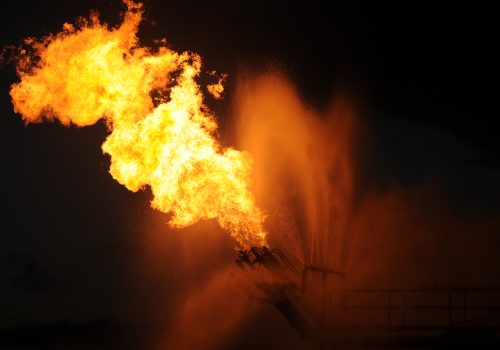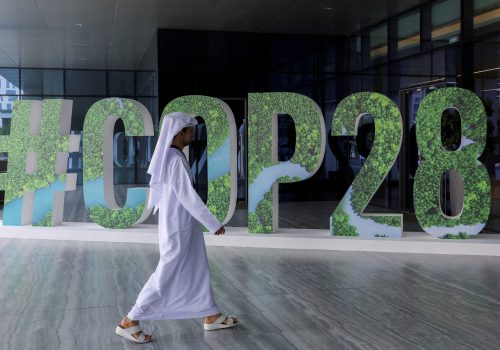A cornerstone of the United Arab Emirates’ COP28 presidency has been its proposed commitment to meaningfully bring the oil and gas industry to the table for the first time in order to negotiate a comprehensive, concrete strategy for emissions reductions in the controversial sector. The Oil and Gas Decarbonization Charter is the scorecard for that gambit. Does it succeed, and what can (or should) come next?
What it accomplishes
Perhaps most notable in the charter is the aspiration to “reach net-zero CO2eq emissions (Scope 1 and 2) for operations under our control…by or before 2050.” In addition, signatories publicly pledge to eliminate routine flaring and achieve “near-zero” methane emissions by 2030. The charter achieves corporate commitments to methane reductions that theoretically parallel the country-level commitments of the Global Methane Pledge. It requires each company to sign the charter, a public (albeit voluntary) commitment that includes “required mechanisms” for transparency. Among these are the development and publication of company strategies to achieve scopes one and two emissions reductions by 2030. If not already published, companies must do so no later than 2025, with an update and potentially increased aspiration by 2028, adoption of a to-be-determined “measuring, monitoring, reporting, and verification” system to score progress, and annual publication of their emissions levels.
As of now, fifty oil and gas companies have signed the agreement, publicly committing to its net-zero and other aspirations, representing about 40 percent of global production. Among these are a number of international oil companies (IOCs) such as ExxonMobil, BP and Shell but also several major national oil companies (NOCs) which, as a broad category, have historically been hesitant to make overarching climate commitments. NOC signatories include Saudi Aramco, ADNOC, Petrobras, Sonangol, Libya National Oil Company, and Petronas.
Given the vast diversity of the global oil and gas industry (and challenges/incentive structures therein), this is a significant accomplishment. In this respect, the charter has materially broadened the level of commitment of the upstream oil and gas industry to emissions reductions, both carbon dioxide and methane. While these commitments are voluntary, they are public and now subject to measurement and verification.
What it does not accomplish
Despite an impressive effort to coalesce a wide range of industry stakeholders around a shared ambition, there are significant shortcomings to the charter as it stands. These areas represent opportunities for strengthening the agreement as the Global Decarbonization Accelerator (GDA) takes clearer shape. The GDA is a plan launched by the COP28 presidency to speed up system-wide emissions reductions across a range of key sectors, including the oil and gas industry.
Limited breadth
Unfortunately, the charter only addresses a part of the oil and gas value chain and a minority share of oil and gas production. Despite the dozens of signatories, dozens more companies have not signed on to this initial charter; some of these include major developing country NOCs (such as Qatar Petroleum or Mexico’s Pemex) as well as some Western majors including American companies Chevron and Conoco-Philips.
Undoubtedly, there are manifold reasons why individual companies were unable or unwilling to agree to this first iteration of the charter; reluctance to sign on may not necessarily represent a repudiation of its goals or sentiment. However, it is in the interest of the oil and gas sector writ large, as well as major consumers of oil and gas industry products and services, to incentivize those companies not yet aligned with the charter’s laudable goals to reconsider.
Limited commitments
The charter itself places a relatively limited commitment on its signatories that leaves important areas minimally or not addressed at all. For example, the charter addresses the emissions of “upstream” or producing companies, not including the “midstream” companies that transport hydrocarbons or the “downstream” or refining and processing companies that turn them into products (such as liquefied natural gas exports). Within this framing, the agreement only addresses scope one and two emissions and is silent on “scope three emissions” (i.e., emissions from the use of oil and gas products) altogether—for both carbon dioxide and methane. For the oil and gas industry, the use (overwhelmingly combustion) of its products constitutes the vast majority of the industry’s carbon footprint.
In another example, signatories pledge to work with partners (such as technology companies and data centers) that consume massive amounts of power, but those partners make no commitments under this particular agreement. Likewise, charter members address “operations under their control” but pledge to work with their partners on non-operated projects, ones where NOCs or non-signatories control operations. This is a recognition of the massive volume of oil and gas production by companies that, so far, have refused to spend what would be required to achieve significant reductions (e.g., such as tools to prevent flaring).
A differentiated approach
Importantly, the charter speaks to “differentiated approaches” many times, a recognition that the IOCs that signed the agreement are already on a faster track to emissions reductions than many of their NOC peers. The charter also understandably refers to the need for supportive governmental policies, the importance of a full suite of emissions reducing technologies from direct air capture to carbon capture and sequestration, and the need for permitting reform to expedite the siting and construction of infrastructure. It also speaks to the importance of energy security and alleviating energy poverty in line with the UN Sustainable Development Goals, which remains a significant challenge in many low-income countries. All of these are key acknowledgments given the salience of the energy trilemma in a world attempting to fundamentally transform its energy systems.
Is this meaningful?
The charter achieves three meaningful contributions. It significantly broadens the commitment to emissions reductions, especially methane, by bringing a wider range of companies into the fold. It has secured highly public commitments by fifty companies, a commitment weighty enough to have given pause to many IOCs and NOCs that might be concerned that the targets are out of reach. It unequivocally extracts recognition by major members of the oil and gas industry of responsibility to address emissions quickly while meeting obligation to provide security of supply.
Although laudable, the pace of change for this industry (as represented in this charter) is not fast enough, deep enough, or broad enough to materially address the yawning gap between the Paris commitments and the present Dubai reality. After months of negotiations to achieve this charter, it is now time for governments, consumers, and other stakeholders worldwide to push even further. The oil and gas industry is, after all, a business; it responds to its buyers. The mounting pressure on this industry to begin to change, combined with the perseverance of the COP28 leadership, resulted in this important step forward in addressing its role in climate change. But this charter should be the beginning of a conversation since we are nowhere close to its end.
David L. Goldwyn served as special envoy for international energy under President Obama and assistant secretary of energy for international relations under President Clinton. He is chair of the Atlantic Council’s Energy Advisory Group and a nonresident senior fellow with the Council’s Global Energy Center.
Andrea Clabough is a senior associate at Goldwyn Global Strategies, LLC, and a nonresident fellow with the Council’s Global Energy Center.
Note: Three companies mentioned in this article—ExxonMobil, BP, and ADNOC—are donors to the Atlantic Council’s Global Energy Center. This article, which did not involve these donors, reflects the authors’ views.
Meet the author
Related content

The Global Energy Center develops and promotes pragmatic and nonpartisan policy solutions designed to advance global energy security, enhance economic opportunity, and accelerate pathways to net-zero emissions.
Image: Offshore drilling rig at sunset (Credit: James Jones Jr., Shutterstock)







